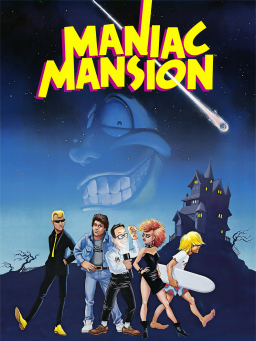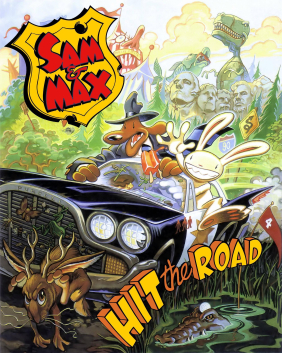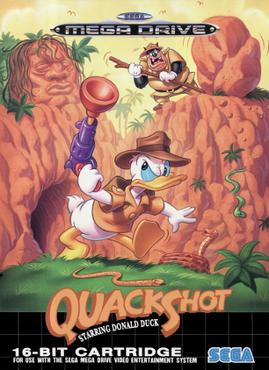Related Research Articles

Maniac Mansion is a 1987 graphic adventure video game developed and published by Lucasfilm Games. It follows teenage protagonist Dave Miller as he attempts to rescue his girlfriend Sandy Pantz from a mad scientist, whose mind has been enslaved by a sentient meteor. The player uses a point-and-click interface to guide Dave and two of his six playable friends through the scientist's mansion while solving puzzles and avoiding dangers. Gameplay is non-linear, and the game must be completed in different ways based on the player's choice of characters. Initially released for the Commodore 64 and Apple II, Maniac Mansion was Lucasfilm Games' first self-published product.

Sam & Max Hit the Road is a graphic adventure video game released by LucasArts during the company's adventure games era. The game was originally released for MS-DOS in 1993 and for Mac OS in 1995. A 2002 re-release included compatibility with Windows. The game is based on the comic characters of Sam and Max, the "Freelance Police", an anthropomorphic dog and "hyperkinetic rabbity thing". The characters, created by Steve Purcell, originally debuted in a 1987 comic book series. Based on the 1989 Sam & Max comic On the Road, the duo take the case of a missing bigfoot from a nearby carnival, traveling to many American culture tourist sites to solve the mystery.

DuckTales is an American animated television series produced by Walt Disney Television Animation. It originally premiered on syndication on September 18, 1987, and ran for a total of 100 episodes over four seasons, with its final episode airing on November 28, 1990. Based upon Uncle Scrooge and other Duck universe comic books created by Carl Barks, the show follows Scrooge McDuck, his three grandnephews Huey, Dewey, and Louie, and close friends of the group, on various adventures, most of which either involve seeking out treasure or thwarting the efforts of villains seeking to steal Scrooge's fortune or his Number One Dime.

TaleSpin is an American animated television series first aired in 1990 as a preview on Disney Channel and later that year as part of The Disney Afternoon. It features anthropomorphized versions of characters adapted from Disney's 1967 animated feature The Jungle Book, which was theatrically rereleased in the summer before this show premiered in the fall, notably Baloo the Bear, Louie the orangutan, and Shere Khan the tiger, along with new characters created for the show. The name of the show is a play on "tailspin", the rapid descent of an aircraft in a steep spiral, and on the fact that tale is another word for "story". The show is one of nine Disney Afternoon shows to use established Disney characters as the main characters, with the other eight being Darkwing Duck, DuckTales, Chip 'n Dale: Rescue Rangers, Goof Troop, Bonkers, Quack Pack, Aladdin, and Timon & Pumbaa. It is also one of two animated television series based on the book The Jungle Book, the second being Jungle Cubs.

The Fool's Errand is a 1987 computer game by Cliff Johnson. It is a meta-puzzle game with storytelling, visual puzzles, and a cryptic treasure map. It is the tale of a wandering Fool who seeks his fortune in the Land of Tarot and braves the enchantments of the High Priestess. A sequel titled The Fool and His Money was released October 25, 2012.

Beyond Zork is an interactive fiction computer game written by Brian Moriarty and released by Infocom in 1987. It was one of the last games in the Zork series developed by Infocom. It signified a notable departure from the standard format of Infocom's earlier games which relied purely on text and puzzle-solving: among other features, Beyond Zork incorporated a crude on-screen map, the use of character statistics and levels, and RPG combat elements.

QuackShot Starring Donald Duck, released in Japan as QuackShot Gurujia-ō no Hihō, is a 1991 platforming video game developed and published by Sega for the Sega Genesis. The game was released in Europe in 1991, in North America on December 19, 1991, and in Japan the following day. QuackShot stars Donald Duck and his three nephews, Huey, Dewey, and Louie, as treasure-hunters. The game was influenced by the Indiana Jones film series.

Myron "Grim" Natwick was an American artist, animator, and film director. Natwick is best known for drawing the Fleischer Studios' most popular character, Betty Boop.

Dark Castle is a 1986 platform game for Macintosh that was originally published by Silicon Beach Software. The original game was designed and animated by Mark Pierce and programmed by Jonathan Gay with Real Sound by Eric Zocher. In Dark Castle, a young hero named Duncan tries to make his way to the evil Black Knight, dodging objects as well as solving occasional puzzles.

3 in Three is a 1989 metapuzzle video game designed by Cliff Johnson and published by Cinemaware and Inline Design.
The Fool and His Money is a puzzle game by Cliff Johnson. It is a self-published sequel to the 1987 game The Fool's Errand. Like its predecessor, The Fool and His Money contains many different types of logic and word puzzles which, although centered on a story with a medieval tarot deck theme, have added elements of the Prince, Egyptian gods, and Pirates.

At The Carnival is a puzzle video game by Cliff Johnson published in 1989 by Miles Computing.

Toonstruck is a graphic adventure video game developed by Burst Studios, published by Virgin Interactive Entertainment and released in 1996 for DOS. The game features hand-drawn imagery and animated characters, but the protagonist Drew Blanc is represented as a video-captured live action character interacting with the cartoon world around him. In the game, Blanc is transported into the cartoon world he created while suffering from a creative block. Blanc is accompanied by his animated sidekick Flux Wildly.
Games World of Puzzles is an American games and puzzle magazine. Originally the merger of two other puzzle magazines spun off from its parent publication Games magazine in the early 1990s, Games World of Puzzles was reunited with Games in October 2014.
A metapuzzle, also known as a meta-puzzle or meta, is a puzzle that uses the solutions to a set of puzzles to create or provide data for a final puzzle.

Mysterious Stranger: A Book of Magic by illusionist David Blaine was published on October 29, 2002 by Random House. Part autobiography, part history, and part armchair treasure hunt, the book also includes instructions on how to perform basic card tricks and illusions.

Dust: A Tale of The Wired West is a computer game made for PC and Macintosh. It was released on June 30, 1995, and was produced by Cyberflix and published by GTE Entertainment.

Quest for Glory: So You Want to Be a Hero is a 1989 adventure game/role-playing game hybrid, designed by Lori Ann Cole and published by Sierra On-Line for MS-DOS. It is the first game in the Quest for Glory series, and has been credited for being a genre-defining game, as it tried to mix graphical adventure gaming with role-playing-like elements such as statistic building that would actually affect the ability to accomplish certain parts of the game. The game has a satirical and silly tone. Ports for the Amiga, Atari ST, and NEC PC-9801 were released in the early 1990s. A VGA remake, titled Quest for Glory I: So You Want to Be a Hero, was released in 1992 for DOS and later in 1994 for Mac OS.
Weekend Pussy Hunt was an Internet-only film noir cartoon series created by John Kricfalusi, starring Dirty Dog and Cigarettes the Cat. The series was initially developed for MSN, which billed it as "the world's first interactive web-based cartoon" and slated it for release in June 1997, but MSN stopped the production before the cartoon was finished. In 1999 the series began airing on Icebox.com, after the release of Spümcø's own web-based Flash cartoon, The Goddamn George Liquor Program. The first scene was animated prior to Flash's acquisition by Macromedia, when the software was still called FutureSplash Animator.
References
- 1 2 3 "Cliff Johnson". fools-errand.com. Retrieved April 29, 2023.
- 1 2 3 Maher, Jimmy (November 20, 2015). "Cliff Johnson's Fools Errand". The Digital Antiquarian. Retrieved April 29, 2023.
- ↑ "Retrospective: Cliff Johnson" (PDF). GamesTM. Archived from the original (PDF) on 2005-11-03. Retrieved September 23, 2017.
- ↑ Johnson, Cliff. "Mysterious Stranger Book Excerpts". fools-errand.com. Retrieved April 29, 2023.
- ↑ Levy, Steven; Mello, Adrian (December 1989). "The Game Hall of Fame". Macworld . 6 (12). IDG Communications: 165–166.